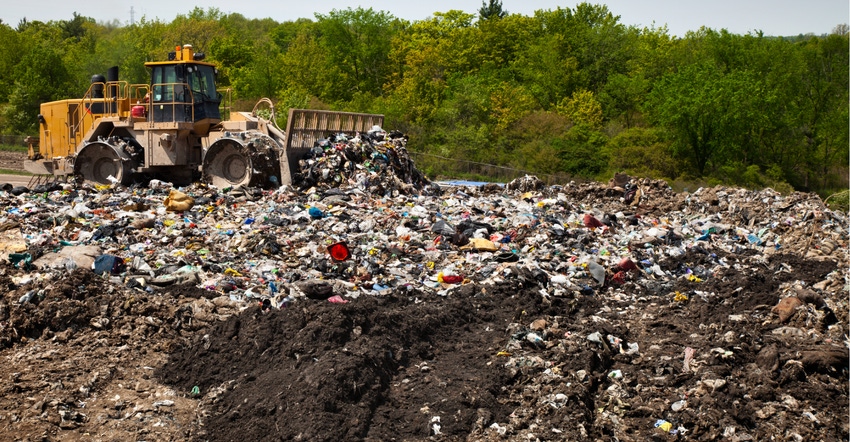June 10, 2020

Located on Lake Michigan at the northern edge of Illinois but part of the metropolitan area known as Chicagoland, the village of Winthrop Harbor lives up to its name big time. It is quiet, serene North Point Marina, with some 1,500 slips, is the largest public moorage on the Great Lakes.
About four miles west of the Marina sits the Zion Landfill owned and operated by Advanced Disposal Services (ADS). The site opened in the mid-1970s and accepts municipal solid waste, construction and demolition debris, non-hazardous industrial waste, contaminated soil and asbestos. Municipal waste and C&D, by themselves, account for about 1,500 tons per day. It is one of two active landfills in Lake County.
Kurt and Julie Andrews and Patricia Napier (plaintiffs) are Winthrop Harbor residents whose homes are near the landfill. Although the landfill existed when they moved into the neighborhood, ADS expanded the landfill in 2011 and again in 2014, extending its life until approximately 2028 and moving its operations closer to where they live.
The plaintiffs took ADS to court, alleging that they must now endure noxious odors, large amounts of airborne dust and debris, excessive noise, and flocks of vermin. Their case was based on three elements: first, negligent operation, maintenance and/or control of the landfill expansions; second, substantial interference with the use, enjoyment, and/or occupancy of their properties; and third, causing a wrongful, unlawful, and unreasonable entry of materials, excessive noise conditions, and/or vermin onto their properties.
Following a nine-day trial, the jury returned a verdict in favor of ADS. Judge Jorge L. Ortiz denied the plaintiffs' motions to undo the verdict and hold a new trial, and entered a judgment for ADS. A three-judge panel of the Illinois Appellate Court upheld his decision, finding no errors that would warrant a reversal and a new trial.
On appeal, the plaintiffs argued that Judge Ortiz was wrong in his pre-trial determination of how their damages should be calculated and that other rulings by him during the trial warranted overturning the decision. Putting aside the damages issue, the panel put first things first: Was ADS legally responsible for the conditions the plaintiffs experienced? That inquiry began with a review of the expert testimony presented by each side.
As the Plaintiffs saw it, the trial court unfairly allowed ADS's engineering expert, Suresh Relwani, to testify about the result of odor-testing throughout the plaintiffs' neighborhood, but restricted similar testimony from plaintiffs’ expert. In addition, they contended that Judge Ortiz wrongfully barred evidence of other residents' complaints about odor in the neighborhood.
Dr. Neil Williams, an engineering expert, testified extensively on behalf of the plaintiffs about the landfill’s impacts, including its odors, on the community overall. Later, when the plaintiffs tried to offer into evidence exhibits showing complaints of odor from locations other than the property owned by the plaintiffs, the trial court sustained ADS’s objections, perhaps on the basis of hearsay. In rebuttal to Dr. Williams' testimony, the court allowed defendant's expert, Mr. Relwani, to testify about the results of his odor-testing throughout the neighborhood.
An appeals court will overturn a trial court's decision to admit or exclude evidence when the ruling is arbitrary, unreasonable or ignores recognized legal principles. In short, it must be a ruling that no fair-minded, knowledgeable, competent judge would have made. The appeals court found Judge Ortiz’s rulings to be evenhanded. “[T]he court's application of its standard for admissibility was consistent and, therefore, not an abuse of discretion,” the opinion stated.
During closing argument to the jury, ADS’s attorney stated that the facility was “operating lawfully,” which merely reiterated unrebutted testimony by the landfill manager concerning compliance with siting requirements, regulations and permits. On appeal, the plaintiffs claimed that the trial judge was wrong in allowing such a statement. At times, what a lawyer says to a jury in closing arguments, if such remarks are deemed prejudicial, can be grounds for a new trial. “Plaintiffs, however, did not object to this statement of defendant's counsel, nor did they object during the trial to the testimony of the landfill manager [or] raise this issue in their post-trial motion,” noted the panel. “Accordingly, we need not consider the merits of plaintiffs' argument.”
The plaintiffs also contended that Judge Ortiz mistakenly permitted ADS to argue during closing argument that the plaintiffs "came to the nuisance" – that is, they freely chose to subject themselves to the neighboring activity. A nuisance occurs when one landowner engages in conduct that significantly interferes with or otherwise negatively affects another’s ability to use and enjoy their own property or that may affect health, safety and welfare.
A commonly asserted defense to a nuisance claim is that the defendant was engaged in the offending activity before the complaining party arrived and became afflicted by the activity. (Take the case of a prominent music studio that has been operating for many years. Despite knowing that sound would regularly be heard on an adjoining property, a party buys that property and then complains about the noise.) ADS conceded that “who was there first” does not absolutely block the plaintiffs’ claim, but successfully asserted that it does remain relevant in determining liability. The trial court declined to adopt the plaintiffs’ interpretation of “coming to the nuisance” when it instructed the jury before its deliberations, and the appeals court upheld the ruling.
Juries commonly render only a general verdict. Where a plaintiff prevails in a civil case, the verdict form, signed by the foreperson, may read simply as follows:
We, the jury, unanimously find that the Plaintiff, __________, proved by
a preponderance of the evidence each of the elements of her claim(s).
We, the jury, further unanimously find that the Plaintiff, _________, proved
by a preponderance of the evidence that she is entitled to compensatory
damages in the amount of $ _____________.
A trial judge or any party may require a jury in its deliberations to address and answer one or more significant questions of fact. Known as “special interrogatories,” these questions must be submitted for the jury’s consideration if they involve dispositive facts – that is, conditions and circumstances that would control the verdict. If a jury’s findings of fact don’t correspond with its general verdict, the former overrides the latter and the court will enter a judgment contrary to the verdict.
Over plaintiffs’ objection, ADS submitted 32 special interrogatories to the jury, and the judge allowed them. They were aimed at the three legal theories on which the plaintiffs hoped to recover damages, and they generally addressed these key liability elements:
On the negligence count, interrogatories asked the jury with respect to each of the plaintiffs' households: "Did Defendant act as a reasonably careful landfill would act under the circumstances shown by the evidence throughout the relevant period of time that is the subject of the lawsuit?"
On the nuisance count, interrogatories asked whether each plaintiff proved "that Defendant was responsible for causing an invasion of their interest in their use and enjoyment of their property" through noise, dust, birds, litter, or odor; "that any such invasion was something that was offensive physically, to the senses and by such offensiveness made life uncomfortable"; that "any such invasion was substantial"; that "any such invasion was intentional"; that "any such invasion was negligent"; and that "any such invasion was unreasonable."
On the trespass count, interrogatories asked whether each plaintiff proved that ADS caused birds or litter to invade their land. The jury was further asked, "[i]f you found that [plaintiff] proved that such a thing invaded her land, did that invasion subtract from her interest in her exclusive possession or use of her property"; "did that invasion occur because of intentional acts of the Defendant"; and "did that invasion occur because of negligent acts of Defendant?"
The appeals court rejected the plaintiffs’ argument that these special interrogatories were improper because they did not home in on the ultimate issues of liability resolved in the verdict. On the contrary, “defendant's multiple special interrogatories address each of plaintiffs' theories of negligence, private nuisance, and trespass . . . [focusing] on . . . one element that is dispositive of [each] claim."
The plaintiffs also challenged the court's finding that the landfill was "at best" a temporary nuisance. As a result, they argued, the jury was deprived of the opportunity "to determine the nature of the nuisance and apply the appropriate measure of damages after hearing all of the evidence." However, whether a nuisance is temporary or permanent is relevant only with respect to damages, and not to liability. “The question of the appropriate measure of damages does not arise unless liability is established, and the jury found no liability,” the panel said.
Kurt and Julie Andrews, et al. v. Advanced Disposal Services Zion Landfill, Inc., No. 2-19-0278, Ill. App. Ct., Second Dist., Feb. 13, 2020.
About the Author(s)
You May Also Like




